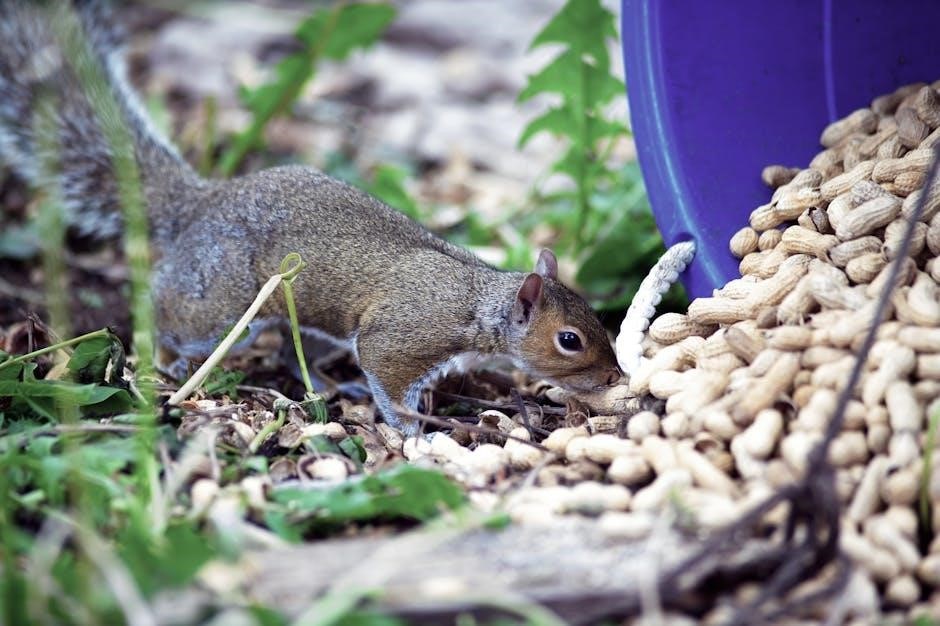Taste of the Wild feeding guide helps pet owners ensure their pets receive proper nutrition. It provides essential feeding schedules and portion sizes for optimal health.
Overview of Taste of the Wild Pet Food
Taste of the Wild is a popular grain-free pet food brand known for its high-protein recipes inspired by the natural diet of wild animals. It uses real roasted meats as the first ingredient, ensuring a flavorful and nutritious meal for pets. The brand offers various formulas, such as High Prairie and Pacific Stream, catering to different protein preferences and dietary needs. Each recipe avoids fillers like grains, making it a favorite for pet owners seeking a more natural diet. Manufactured by Diamond Pet Foods, Taste of the Wild has gained a reputation for its commitment to quality and pet health, though controversies like recalls and DCM concerns have sparked debates among pet owners.
Importance of a Feeding Guide for Pet Owners
A feeding guide is crucial for ensuring pets receive the right amount of nutrients tailored to their age, size, and activity level. It helps prevent overfeeding or underfeeding, which can lead to health issues like obesity or nutrient deficiencies. The guide also provides clarity on portion sizes and feeding frequencies, making it easier for owners to maintain their pet’s optimal weight and energy levels. Additionally, it addresses specific dietary needs, such as grain-free options or high-protein recipes, ensuring pets thrive without unnecessary fillers. By following the guide, owners can make informed decisions about their pet’s diet, fostering long-term health and well-being.

Understanding the Guaranteed Analysis
The Guaranteed Analysis lists the minimum and maximum levels of nutrients like protein, fat, fiber, and moisture in Taste of the Wild pet food, ensuring nutritional standards are met.
Nutritional Content and What It Means for Your Pet
The nutritional content in Taste of the Wild ensures pets receive essential vitamins, minerals, and amino acids. High-quality protein sources like real roasted meats promote strong muscles and energy. Balanced fat levels support skin and coat health, while complex carbohydrates provide sustained energy. The presence of antioxidants helps protect against free radicals, supporting overall immunity. The formula avoids fillers and artificial additives, ensuring each ingredient serves a purpose. This balanced approach supports digestion, vitality, and long-term health, making it suitable for pets of various life stages and dietary needs.
Difference Between All Life Stages and Maintenance Recipes
All Life Stages recipes are formulated for pets at any life stage, while Maintenance recipes cater to specific dietary needs, ensuring tailored nutrition for optimal health.
Which Recipe is Right for Your Pet?
Choosing the right Taste of the Wild recipe depends on your pet’s life stage, health, and dietary needs. All Life Stages recipes support growth and maintenance across all ages, making them ideal for pets with standard requirements. Maintenance recipes, however, are tailored for adult pets needing consistent, balanced nutrition without extra calories. For pets with sensitivities or specific health conditions, limited-ingredient diets or grain-free options may be more suitable. Always consult your veterinarian to determine the best fit, ensuring your pet receives the nutrients needed for optimal health and well-being. This personalized approach helps maximize their quality of life and vitality.

Potential Concerns and Controversies
Some pet owners raise concerns about Taste of the Wild’s use of preservatives like Ethoxyquin and processed ingredients, questioning their long-term health impacts on pets.
Grain-Free Diets and the Risk of DCM
Grain-free diets, including some Taste of the Wild formulas, have been linked to a potential increased risk of Dilated Cardiomyopathy (DCM) in dogs. The FDA has investigated this connection, focusing on ingredients like peas, lentils, and potatoes, which are common in grain-free foods. While Taste of the Wild has not been directly implicated in FDA reports, pet owners are advised to consult their veterinarians, especially if their dogs have pre-existing heart conditions. The company emphasizes the importance of a balanced diet and recommends monitoring pets for any signs of illness. This issue remains a topic of ongoing research and debate in the pet food industry.
Recalls and Safety of Taste of the Wild
Taste of the Wild has faced recalls in the past, notably in 2012, due to potential contamination issues. Diamond Pet Foods, the manufacturer, voluntarily recalled several products, including Taste of the Wild formulas, to ensure pet safety. The company has since implemented rigorous quality control measures to maintain high standards. While some concerns exist about certain ingredients, such as Ethoxyquin, the brand emphasizes adherence to regulatory guidelines. Pet owners are encouraged to stay informed about recalls by checking the FDA website or the manufacturer’s updates. Despite past issues, Taste of the Wild remains a popular choice, with many pet owners reporting positive experiences with their products.

Transitioning Your Pet to Taste of the Wild
Transitioning pets to Taste of the Wild should be done gradually, over 7-10 days, to prevent digestive upset. Start with small portions and increase slowly.
Consult a vet for personalized advice and monitor your pet’s health during the change to ensure a smooth adjustment period.
How to Safely Switch Your Pet’s Diet
Switching your pet’s diet to Taste of the Wild requires careful planning to avoid digestive upset. Start by mixing a small amount of the new food with their current diet, gradually increasing the proportion over 7-10 days. This phased approach allows your pet’s stomach to adjust to the new ingredients. Always monitor your pet’s health during the transition, watching for signs of discomfort or allergic reactions. If your pet experiences vomiting, diarrhea, or lethargy, slow down the transition or consult a veterinarian for guidance. A smooth transition ensures your pet adapts well to the new food, maintaining their overall health and energy levels.
Feeding Schedules and Portions
Determining the right feeding schedule and portion size is crucial for your pet’s health. Use the feeding chart on the bag, adjust based on activity and age, and monitor weight changes.
How Much and How Often to Feed Your Pet
Feeding your pet the right amount and frequency is essential for their health. Use the feeding guide on the bag as a starting point, adjusting based on your pet’s age, weight, activity level, and metabolism. Overfeeding can lead to obesity and related health issues, while underfeeding may result in malnutrition. Monitor your pet’s condition and adjust portions accordingly. Puppies may need more frequent meals, typically 2-3 times a day, while adult dogs can thrive on 1-2 meals daily. Always ensure fresh water is available. Consult your veterinarian if you’re unsure about the ideal feeding schedule for your pet.

Choosing the Right Formula for Your Pet’s Needs
Selecting the right Taste of the Wild formula ensures your pet receives tailored nutrition. Consider their life stage, health conditions, and dietary preferences for optimal health benefits.
High Prairie, Pacific Stream, and Other Formulas
Taste of the Wild offers a variety of formulas tailored to meet specific dietary needs. High Prairie recipes feature real roasted meats like buffalo and lamb, while Pacific Stream focuses on fish-based proteins. Both are grain-free and rich in antioxidants. These formulas cater to pets requiring high energy or those with sensitivities. Other options include Wetlands and Southwest Canyon, providing diverse protein sources. Each formula is designed to mimic natural diets, ensuring pets receive balanced nutrition. With no fillers or artificial flavors, these recipes support overall health and vitality, making them suitable for pets with unique nutritional requirements.
Addressing Common Misconceptions
Some believe Taste of the Wild is unsafe due to past recalls, but current formulas meet strict safety standards. Misconceptions about grain-free diets causing DCM persist, though evidence remains inconclusive.
Myths vs. Facts About Taste of the Wild
Myths surround Taste of the Wild, such as claims of harmful preservatives like Ethoxyquin, but current formulas no longer include it. Another myth is that all grain-free foods cause DCM, though research remains inconclusive. Some believe Taste of the Wild was recalled due to safety issues, but past recalls were resolved, and current products meet strict standards. Fact: Taste of the Wild offers high-protein, natural recipes with real roasted meats, suitable for pets with food sensitivities. While no food is perfect, it remains a popular choice for pet owners seeking grain-free, nutrient-rich options. Always consult your vet for personalized advice.
Taste of the Wild offers a nutrient-rich, natural diet for pets, with formulas catering to various life stages and dietary needs. While concerns like DCM and recalls exist, current products meet safety standards. Pet owners should consult their vet to choose the right formula, ensuring a smooth transition and monitoring their pet’s health. Balanced nutrition and proper feeding schedules are key to your pet’s well-being. Always verify ingredient lists and seek professional advice for personalized feeding plans. With careful consideration, Taste of the Wild can be a healthy, satisfying choice for your pet’s dietary requirements.
